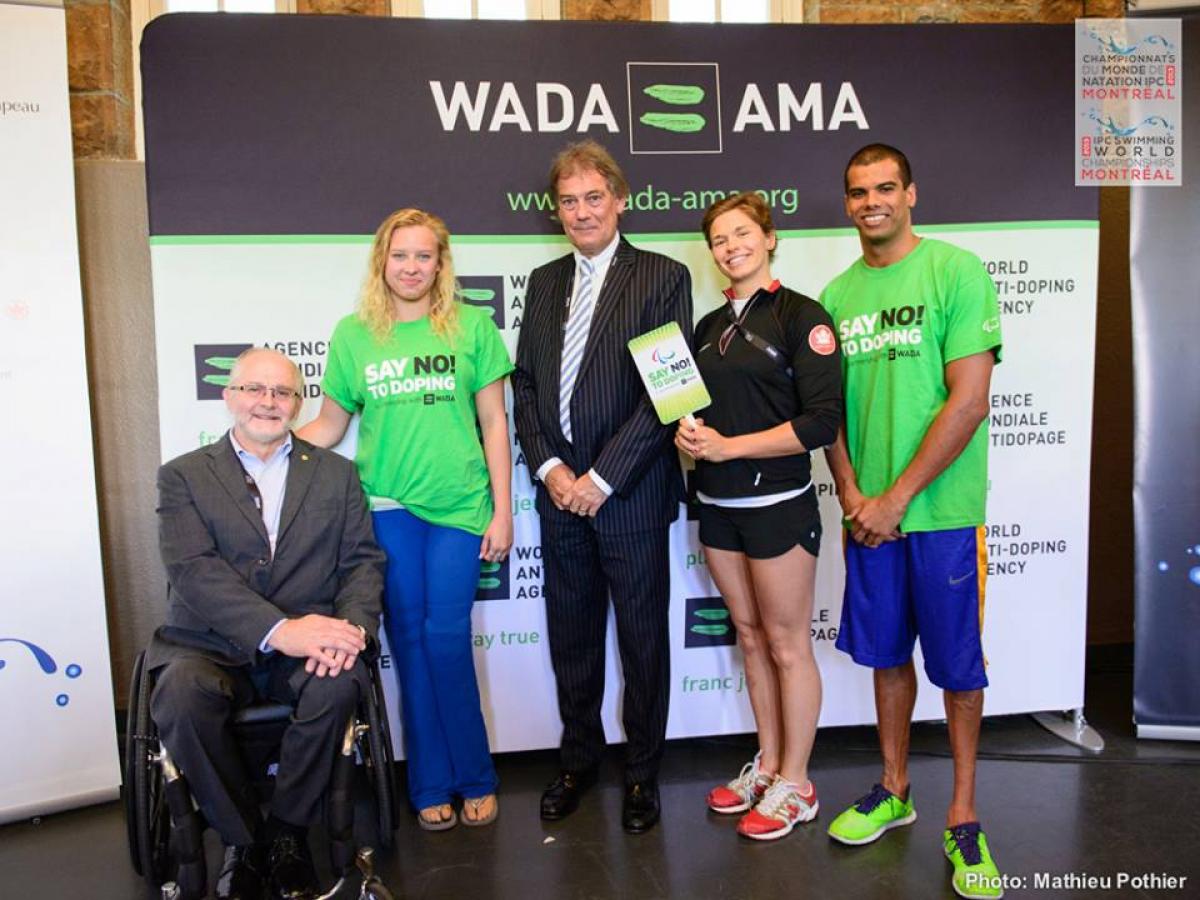WADA approves 2014 Prohibited List of substances
The new list of prohibited substances and methods will be made public on October 1 and will take effect on January 1. 13 Sep 2013
The USA's Jessica Long, Canada's Valerie Grand'Maison and Brazil's Andre Brasil all took part in a "Say No 2 Doping" press conference at the 2013 IPC Swimming World Championships in Montreal, Canada.
“It is WADA’s duty to lead and shape the scientific debate and serve as the catalyst for scientific advancements in the fight against doping in sport. Updating the List has been, and remains a central part of that role.”
The World Anti-Doping Agency (WADA) met in Buenos Aires, Argentina on Wednesday (11 September), as the executive committee discussed the progress toward the revised World Anti-Doping Code in addition to International Standards, science research funding, development of the anti-doping laboratory network, introduction of the Steroidal Module, and the 2014 Prohibited List and Monitoring Programme.
Prohibited List
The executive committee approved the 2014 List of Prohibited Substances and Methods. The new List will be made official and published by October 1 and will take effect on 1 January 2014.
As one of the cornerstones in the global fight against doping, the List specifies substances and methods prohibited in sport and is a mandatory document for all organisations that have adopted the World Anti-Doping Code.
The annual revision of the List is a highly consultative process facilitated by WADA, and begins with circulation of a draft List amongst its stakeholders. Comments are considered by WADA’s List Expert Group, which then presents its conclusions to WADA’s Health, Medical and Research Committee.
Following this, recommendations are made to WADA’s Executive Committee, which discusses the proposals before making a final decision at its September meeting.
“It is WADA’s duty to lead and shape the scientific debate and serve as the catalyst for scientific advancements in the fight against doping in sport. Updating the List has been, and remains a central part of that role,” explained WADA President John Fahey.
“The List is updated annually following a highly democratic consultation process with our stakeholders. We are confident that since 2004 - the year in which WADA assumed responsibility for the List – we have developed a robust process that allows us to deliver the most comprehensive document possible.
“Every year, WADA is presented with new scientific and medical challenges. Updating the List on an annual basis is one of the ways by which we keep on top of these challenges.
“The changes for 2014 will again add greater clarity to the List, and ensure that this document is able to better serve the anti-doping community.”
Monitoring Programme
WADA, in consultation with signatories and governments, is mandated to establish a Monitoring Programme for substances which are not on the Prohibited List but which it wishes to monitor in order to detect patterns of misuse in sport.
Stimulants bupropion, caffeine, nicotine, phenylephrine, phenylpropanolamine, pipradrol, pseudoephedrine (< 150 micrograms per milliliter), synephrine, and narcotics hydrocodone, mitragynine, morphine/codeine ratio, tapentadol and tramadol have all been added to the 2014 Monitoring Programme for possible in-competition abuse. In addition, glucocorticosteroids have been added to the Programme for possible out-of-competition abuse.
2015 World Anti-Doping Code and International Standards
Following the extensive stakeholder and consultation process the Code Drafting Team (CDT) has continued to address feedback received from stakeholders and from the executive committee.
The executive committee discussed the progress of the 2015 Code and the accompanying International Standards for Testing and Investigations (ISTI), Therapeutic Use Exemptions (ISTUE), Laboratories (ISL) and the Protection of Privacy and Personal Information (ISPPI), and approved the drafts.
The 2015 Code and International Standards will be ratified at the forthcoming World Conference on Doping in Sport in Johannesburg, South Africa in November.
New scientific research projects
As is traditionally the case at its September meeting, the Executive Committee approved scientific research projects for funding.
There were 103 research proposals were received this year from 30 countries from all five continents, with 29 being selected by WADA’s Health, Medical and Research Committee.
These projects will help advance anti-doping research in such areas as longitudinal monitoring for testosterone abuse, new challenges in insulin detection, autologous blood testing and EPO gene doping detection. Project descriptions will be posted on WADA’s website once contracts have been signed.
Where applicable, these projects will undergo further review by independent ethical examiners, a process which will be completed in the coming months.
Development of the Anti-Doping Laboratory Network
The strategy for the future development of the anti-doping laboratory network was approved.
At present, 33 laboratories are accredited by WADA, and compose the current global network of anti-doping analytical capability. The executive committee approved the number of WADA-accredited anti-doping laboratories be restricted at 40 over the next five years, and include better global/regional coverage; and further approved the development of blood analysis capacity in countries or areas of the world with limited or no blood analytical capability.
The WADA Science Department dedicated more than 30 per cent of its operational budget to support anti-doping laboratory activities in 2012, in keeping with a steady significant growth in recent years.
Introduction of Steroidal Module
The executive committee approved the Technical Document on Endogenous Anabolic Androgenic Steroids – Measurement and Reporting (TD2014EAAS) to come into effect on 1 January 2014. This is the critical document that allows the implementation of the steroidal module of the Athlete Biological Passport (ABP) in ADAMS.
As with the hematological module currently in operation, the fundamental principle of the Steroidal Module is based on the monitoring of selected parameters over time that indirectly reveal the possibility of doping.
Operating guidelines and related documents intended for the management of the Steroidal Module are in preparation and will be published before the end of the year well ahead of the launch.





